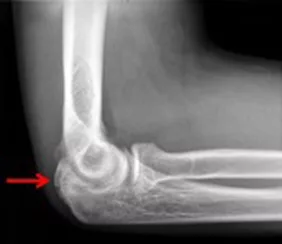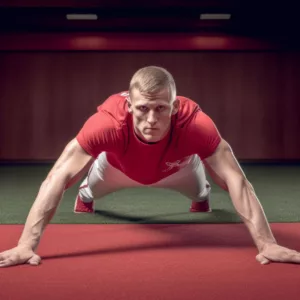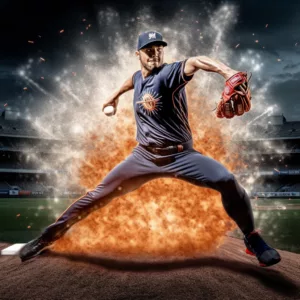 Pitching elbow pain is a common complaint among athletes, particularly baseball players, who perform repetitive throwing actions. This article is a detailed reference that provides helpful insights into the signs and treatments of pitching elbow pain. Whether you're an athlete suffering discomfort or an individual seeking information on the subject, this article intends to provide you with the knowledge you need to get a better understanding of pitching elbow pain and properly treat it.
Pitching elbow pain is a common complaint among athletes, particularly baseball players, who perform repetitive throwing actions. This article is a detailed reference that provides helpful insights into the signs and treatments of pitching elbow pain. Whether you're an athlete suffering discomfort or an individual seeking information on the subject, this article intends to provide you with the knowledge you need to get a better understanding of pitching elbow pain and properly treat it.
This article seeks to empower those living with pitching elbow pain by analyzing common symptoms and providing an overview of various treatments. Understanding the symptoms of this condition, such as persistent discomfort, edema, reduced range of motion, weakness, and other symptoms, can aid in early discovery and rapid action. Furthermore, understanding the many treatment options, such as rest, physical therapy, medication, and, in severe situations, surgical intervention, can help individuals make informed healthcare decisions. This article aims to provide thorough and accurate information to assist individuals manage pitching elbow pain and restore their best performance, whether you're looking for preventive measures or recommendations on when to seek medical attention.
Symptoms of Pitching Elbow Pain
 Pitching elbow pain is characterized by a variety of symptoms that can range in severity. Understanding these signs is essential for early discovery and treatment. Here are some of the most typical signs of pitching elbow pain:
Pitching elbow pain is characterized by a variety of symptoms that can range in severity. Understanding these signs is essential for early discovery and treatment. Here are some of the most typical signs of pitching elbow pain:
- Elbow joint pain that persists: Persistent pain in the elbow joint is one of the key symptoms of pitching elbow pain. Athletes may feel a dull discomfort or severe pain during or after throwing activities. The pain can spread to the forearm and interfere with regular tasks.
- Inflammation and swelling: Individuals suffering from pitching elbow pain usually experience swelling and inflammation around the elbow joint. The affected area may develop apparent redness and pain as a result of this.
- Restricted range of motion: Pitchers suffering from elbow pain may experience decreased range of motion in their affected arm. Flexion and extension movements can be difficult and uncomfortable.
- Instability and weakness: Pitchers may have arm weakness and instability as well. This can have an effect on their ability to create power and control while throwing.
- Tingling or numbness: Individuals suffering from pitching elbow pain may have numbness or tingling sensations in their fingers or hands in some circumstances. This could be the result of nerve compression or inflammation.
Pitching Elbow Treatment Options
 Proper diagnosis and therapy are critical for properly managing pitching elbow pain. Depending on the severity of the problem, the treatment technique may differ. The following are some of the most widely advised remedies for pitching elbow pain:
Proper diagnosis and therapy are critical for properly managing pitching elbow pain. Depending on the severity of the problem, the treatment technique may differ. The following are some of the most widely advised remedies for pitching elbow pain:
- Changes in activity and rest: Rest is essential for the elbow joint to heal. Athletes suffering from pitching elbow pain should avoid activities that aggravate the condition and alter their training regimen accordingly. This could imply lowering throwing frequency or intensity.
- Physiotherapy: Physical therapy is important in the treatment of pitching elbow pain. A trained therapist can create a customized workout program to strengthen the muscles surrounding the elbow joint, increase flexibility, and encourage optimal biomechanics during throwing motions.
- Cold and heat treatment: Cold packs applied to the affected area might help reduce inflammation and pain. Warm compresses or heating pads, for example, can stimulate blood circulation and aid in the healing process.
- PRP (platelet-rich plasma) therapy: PRP therapy is a regenerative therapeutic approach in which concentrated platelets are injected into the afflicted area. Growth factors in these platelets can hasten tissue repair and minimize inflammation.
- Sixth, surgical intervention: When conservative therapy fails to provide relief in extreme situations, surgical intervention may be required. Tommy John surgery, for example, can correct structural issues and replace torn ligaments in the elbow.
Elbow Protection with the 3X Pitching Velocity Program
 The 3X Pitching Velocity Program is a thorough training program that focuses on increasing pitching velocity while simultaneously protecting the elbow. This program attempts to maximize performance while lowering the risk of elbow injuries by including both strength training and mechanical training. Here's how to use the 3X Pitching Velocity Program to protect your elbow:
The 3X Pitching Velocity Program is a thorough training program that focuses on increasing pitching velocity while simultaneously protecting the elbow. This program attempts to maximize performance while lowering the risk of elbow injuries by including both strength training and mechanical training. Here's how to use the 3X Pitching Velocity Program to protect your elbow:
Muscle Building
The first part of the 3X Pitching Velocity Program focuses on strengthening the muscles that surround the elbow joint. You can provide better support and protection to the elbow during the throwing motion by strengthening and stabilizing these muscles. Typical exercises in the program include:
- Rotator cuff exercises: These workouts target the muscles that stabilize the shoulder, which indirectly protects the elbow from overuse.
- Forearm exercises: Forearm muscle strengthening helps enhance grip strength and general forearm stability, minimizing pressure on the elbow joint.
- Triceps and biceps exercises: Triceps and biceps exercises assist balance the pressures imposed on the elbow joint during the pitching motion.
It is critical to perform the exercises suggested by the program and gradually raise the intensity and resistance over time to ensure that the muscles around the elbow are appropriately conditioned to meet the demands of pitching.
Mechanical Education
 The 3X Pitching Velocity Program also emphasizes good pitching mechanics to reduce unneeded elbow joint strain. You can lessen the risk of excessive stress and torque on the elbow by refining your throwing technique. The following items may be included in the program:
The 3X Pitching Velocity Program also emphasizes good pitching mechanics to reduce unneeded elbow joint strain. You can lessen the risk of excessive stress and torque on the elbow by refining your throwing technique. The following items may be included in the program:
- Video analysis: Recording and analyzing your pitching mechanics with the help of a coach or trainer can reveal any defects or inefficiencies in your technique that may be putting too much strain on the elbow.
- Exercises and drills: Specific drills and workouts that focus on improving pitching mechanics, such as optimal stride length, hip rotation, arm path, and follow-through, are frequently incorporated into the program. These workouts develop a more fluid and effective throwing motion, which reduces elbow stress.
The 3X Pitching Velocity Program provides a holistic approach to protecting the elbow while improving pitching performance by combining strength training to create the necessary muscular support and mechanical training to optimize pitching mechanics. To guarantee perfect form and technique throughout the training process, it is critical to follow the program's requirements and seek help from a skilled coach or trainer.
Remember that putting elbow protection first through proper training practices is critical for long-term pitching success and reducing the chance of elbow injuries.
Frequently Asked Questions (FAQs)
- Can non-athletes have pitching elbow pain?
Yes, while pitching elbow pain is often linked with athletics, it can also occur in those who participate in repeated arm motions or activities that place strain on the elbow joint. - How long does it take for a pitcher's elbow to heal?
The length of recovery depends on the severity of the ailment, commitment to treatment regimens, and personal circumstances. Mild cases may resolve after a few weeks with proper rest and therapy, however more severe cases may take months or longer. - Are there any precautions that can be taken to lessen the risk of pitching elbow pain?
Yes, athletes can take precautions to lessen their chances of developing pitching elbow injury. Maintaining appropriate throwing mechanics, adequately warming up before exercises, gradually increasing training intensity, and avoiding overuse are all examples. - Can pitching elbow soreness cause long-term problems?
Pitching elbow pain, if left untreated or badly managed, can develop to long-term problems such as chronic pain, limited range of motion, and diminished performance in sports activities. - Can complementary therapies such as acupuncture aid with pitching elbow pain?
While some people claim beneficial results from alternative therapies such as acupuncture, empirical evidence supporting their efficacy in treating pitching elbow pain is lacking. Before pursuing alternative treatment alternatives, it is critical to contact with a healthcare expert. - When should I see a doctor about pitching elbow pain?
If you have persistent or worsening elbow pain, swelling, or difficulty moving your arms, you should seek medical assistance. A healthcare professional can provide an accurate diagnosis, offer the best therapy, and help you avoid further issues.
Remote Coaching 3X Pitching Velocity Program
 Are you ready to increase your pitching velocity while protecting your elbow? Sign up for our remote coaching 3X Pitching Velocity Program today to reach your peak pitching potential!
Are you ready to increase your pitching velocity while protecting your elbow? Sign up for our remote coaching 3X Pitching Velocity Program today to reach your peak pitching potential!
Our program is designed to provide personalized advice and support from qualified coaches who specialize in pitching mechanics and performance enhancement. Whether you're an experienced athlete or just getting started, our remote coaching program allows you to exercise from the comfort of your own home while receiving expert assistance suited to your specific needs.
Don't allow pitching elbow aches to stop you. When you join our program, you will have access to a thorough training routine that includes strength training, mechanical corrections, and film analysis. Our professional coaching staff will work directly with you, providing feedback, addressing weaknesses in your technique, and assisting you in developing the velocity and control required to excel on the mound.
Take the first step toward your pitching goals and elbow protection. Sign up for our remote coaching 3X Pitching Velocity Program today and see how expert advice can improve your performance. Don't pass up this chance to improve your game and realize your true pitching ability.


